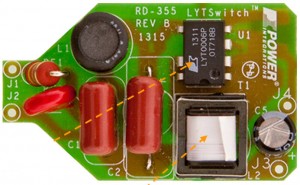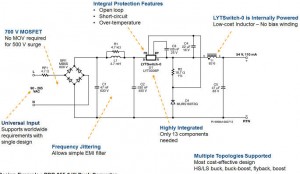Power Integrations goes for LED GU10s
Power Integrations goes for LED GU10s
 Power Integrations is aiming for the most price-competitive end of the LED lighting with a chip for incandescent light bulb replacement, including the challenging GU10.
Power Integrations is aiming for the most price-competitive end of the LED lighting with a chip for incandescent light bulb replacement, including the challenging GU10.
Called LYTSwitch-0, the family implements a single-stage non-dimmable non-isolated topology for loads up to 10W.
“Two stage is unsustainable in terms of cost,” marketing manager Peter Robertson told Electronics Weekly. “A LYTSwitch-0 design has about 13 components: the BOM is cheap.”
This is for a high-side switched buck converter. With more components, other modes can be implemented including: low-side buck, buck-boost, fly-back and boost.
With a 700V main switch on-board, operation from ac inputs of 85 to 308V can be sustained.
 To go with the chip family, the firm has released a 6W GU10 bulb reference design (RDR-355) with 110mA output into a 54V (nominal) LEDs string – a ceramic tile-style multi-die array, for example.
To go with the chip family, the firm has released a 6W GU10 bulb reference design (RDR-355) with 110mA output into a 54V (nominal) LEDs string – a ceramic tile-style multi-die array, for example.
A 6W GU10 reference design, with Power Integrations’ annotations
Key parameters for the universal input design are: 0.82 power factor and 92.1% efficiency at 120V, and 0.52 power factor and 91.3% at 240V. “This meets EC Eco Design Directive [Lot 19 Part 2] with a power factor over 0.5 and Energy Star [Version1, Draft 4] with a power factor above 0.7,” said the firm. Output regulation is +/-5%.
The efficiency figures are aided by the high output voltage and could be expected to fall if a 3V output design was attempted.
Claimed temperature rise with the specified components and layout supplied from 90V is 27°C.
There is no bias winding in the design. Instead the chip takes power from the drain connection when the main switch is ‘off’, storing supply energy in the bypass capacitor for the rest of the cycle.
Operational frequency is around 66kHz, dithered to ease EMC control.
Excess temperature is an issue with all LED light bulbs as designers have no control over where consumers install them. Overheating leads to short life, particularly if necessary electrolytics get over-hot.
While some chip makers are choosing to reduce current as temperature increases, dimming the LED, before cutting current completely if the situation does not improve, Power Integrations has chosen to operate at constant output up to a threshold temperature, then cut power completely.
Four products: LYT0002, 0004, 0005 and 006, span output currents from 30mA to 280mA over various input voltage ranges and two modes: ‘mostly discontinuous conduction’ (MDCM) and continuous conduction’ (CCM).
“In general, MDCM provides the lowest cost and highest efficiency converter. CCM designs require a larger inductor and ultrafast [~35ns recovery] free-wheeling diode in all cases. It is lower cost to use a larger LYTSwitch-0 in MDCM than a smaller LinkSwitch-0 in CCM because of the additional external component costs of a CCM design. However, if the highest output current is required, CCM should be employed,” said the firm.
Except for the 0002, the family includes automatic re-start circuits for fault conditions
